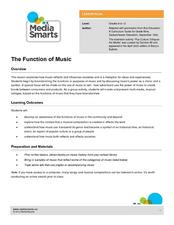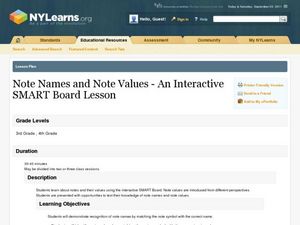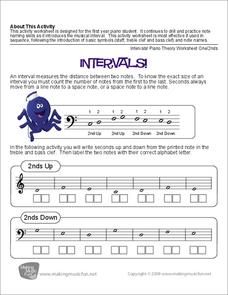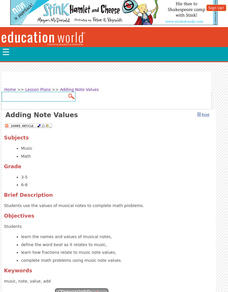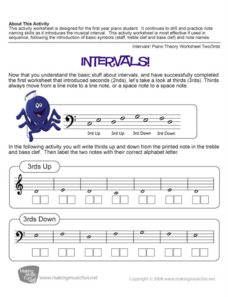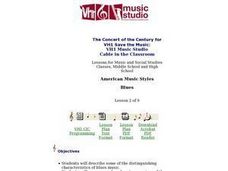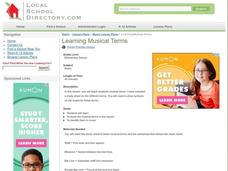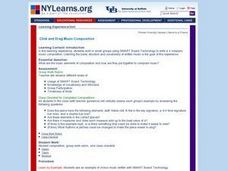abcteach
Music Note Cards
Help young musicians stay on beat with this series of classroom displays. Showing the name and symbol for different musical notes, these tools are a handy resource for any elementary or middle school music teacher.
Curated OER
Music Review Test
Wow this is a really thorough music quiz. There are a total of seven tasks for the class to complete. They must, write the C major scale, identify notes on the staff, write four major keys based on the information provided, identify...
Fun Music Company
Bat Trails: Music Symbols
Whether written for Therese, Elisabeth, or for Juliane, young music theory students will enjoy pursuing the clues hidden in music symbols that indicate who wrote "Fur Elise."
Curated OER
Reading Basic Music Notes
First graders develop skills in reading music notes. In this reading music activity, 1st graders clap and chant rhythm patterns and learn music vocabulary. Students also match patterns by listening to the teacher perform the pattern.
Curated OER
Stop Signs, Musical Notes, Letters & Logos: Designing Symbols
Students develop an awareness of environmental print, such as signs, logos, brand names, and other print and non-print items that the children see and read in their neighborhood each day. They then engage in active problem solving as...
Curated OER
The Function of Music
Explore concepts of audience, purpose and symbols in this lesson from Media Smarts that asks young scholars to consider all the functions of music. Through a series of discussions and activities, your class will brainstorm possible...
Curated OER
Music Box Identification
Fourth graders draw and label music notes and rests. In this music box lesson students use staff paper to draw the notes required. The students give the value of each note or rest.
Curated OER
Outline: Notes of the Treble Clef Staff
Score one for test prep. Young musicians are encouraged to create their own mnemonic devices to prepare themselves for a test on the treble clef staff. Using the provided worksheet, individuals record, in order, the names of the lines...
Fun Music Company
Code Breaking with Music Symbols Representing Letters
Navajo code talkers beware! These kids use music symbols to break the codes and find both the question and the answer to a music trivia question.
MakingMusicFun.net
Intervals! (Fifth) | Free Music Theory Worksheet (Digital Print)
For this music intervals worksheet, students study the music notes in fifths. Students write the fifth notes up and down in the treble and bass clef. Students label the two notes with the correct alphabet letter.
Curated OER
Note Names and Note Values - An Interactive Smart Board Lesson
Using the Note Names and Values SMART notebook file, review the whole, half, quarter and eighth note with students. Students sing "Apple Tree Song." They add body percussion, and then instruments. Students use the SMART apple tree, they...
Curated OER
Musical Note Value
Young scholars will identify each symbol by sight stating the value of each. They will use cardboard notes to who what they have learned so far about the note values creating 4 and 6 count phrases.
MakingMusicFun.net
Intervals! (Seconds) | Free Music Theory Worksheet (Digital Print)
In this music intervals worksheet, students learn the exact size of an interval by counting the number of notes from the first to the last. They write seconds up and down from the printed note in the treble and bass clef. Then, they...
Curated OER
Adding Note Values
Students use the values of musical notes to complete math problems. They study the names and values of musical notes, define the word beat as it relates to music. They complete math problems using music note values.
MakingMusicFun.net
Intervals! (Thirds) | Free Music Theory Worksheet (Digital Print)
For this music worksheet, learners work with thirds as intervals in sheet music. They write thirds up and down before labeling the notes with their correct alphabet letter. They complete two examples.
Curated OER
American Music Styles: Blues - Lesson 2
Students describe some of the distinguishing characteristics of blues music. They compare and analyze two versions of the same 12-bar blues song. They read and identify notation symbols for rhythm and tempo.
MakingMusicFun.net
Intervals! (Fourth) | Free Music Theory Worksheet (Digital Print)
In this music intervals worksheet, students write fourths and name the two notes in their correct alphabetical order. Students name fourteen notes.
Curated OER
Graphic Scores
You can write some music scores using images rather than musical notation. Kids learn how they can become musical composers by using graphics or images in place of musical notation. An interesting slide-show, but a more interesting...
Curated OER
Music Composition
Students compose a simple melody using the notes of the D Major Scale. Criteria/Rubric for evaluation is provided with variations depending on skill level of students. A minimum of one forty-five minute class period is needed for this...
North Carolina Standard Curriculum
Rhythm Counting
Understanding time signatures and rhythm counting are two very important parts of playing an instrument well. Here are three basic lessons rolled into one that prompt upper graders to play their instruments with care. They'll practice...
Classics for Kids
"Mars" from The Planets
Gustav Holst's The Planets provide young musicians an opportunity to examine how composers can create a suite: a collection of smaller pieces grouped to explore a single topic. After listening to "Jupiter," they examine "Mars" in detail,...
Curated OER
Learning Musical Terms
Young scholars observe and discuss the following musical terms and their symbols: staff, measure, bar line, double bar line, treble clef, bass clef, time signature, common time, cut time, quarter note, half note, dotted half note, whole...
Curated OER
Click and Drag Music Composition
Fourth graders work in small groups using SMART Board Technology to write a 4 measure music composition. studying the basic structure and vocabulary of written music is the goal of this experience.
Curated OER
Music Terms Puzzle
In this music worksheet, students complete a crossword puzzle of fourteen basic music terms about instruments, beats, and performance groups.







